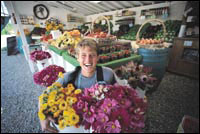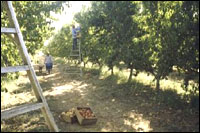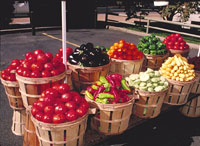
A-tisket, a-tasket, an organic produce
basket.
Photo: USDA.
Organic food has hit the big time. The Whole Foods Market chain, the largest natural-foods retailer in the world, boasts 145 stores throughout North America; its leading competitor, Wild Oats, has 101 stores in 25 states and Canada. Last year, the U.S. Department of Agriculture put in place a set of national standards for organic food, smoothing the way for organic processors who buy ingredients from multiple states. Organic products — fresh produce, frozen pizzas, and everything in between — are now part of a multi-billion-dollar industry that’s growing by 20 to 25 percent each year.
But if you’re reading this over an organic banana or a pesticide-free seaweed salad, don’t sigh with satisfaction just yet. On average, 10 calories of fossil-fuel energy are used in producing, processing, transporting, and preparing every calorie of food we consume in the United States, according to studies by David Pimentel of Cornell University. While organic farming methods can save some energy in the production department, they don’t have the same healthy effect on transportation; organic or not, oranges burn a lot of fuel on their way to Minneapolis.
Some critics say there’s only one way for shoppers, restaurants, and grocery stores to correct this massive resource drain: Go one step “beyond organic” and buy fresh, pesticide-free food from local growers.
Eliot Coleman, who has raised produce in Maine for more than three decades, sells all of his fruits and vegetables within 25 miles of his year-round farm. He says the dominant, USDA-endorsed definition of organic doesn’t fully describe what he does. “It just disavows the negatives — pesticides and chemicals — without embracing the positives,” he says. Coleman argues that shopping locally not only conserves natural resources, but also helps protect small-scale farms like his.

A happy local grower in “Beyond
Organic.”
Photo: Bull Frog Films.
Coleman is part of a loose network of farmers, consumers, and advocacy groups that is trying to push organic agriculture a step closer to sustainability. These activists use a variety of labels to describe what they’re promoting — beyond-organic food, authentic food, even slow food — but they’re all engaged in the surprisingly difficult task of getting local food on local tables.
“Let’s figure out how to serve the local community so that foods are not shipped such long distances,” California farmer and author Michael Ableman said in the recent documentary film “Beyond Organic.” “Let’s create an energy revolution in agriculture.”
Too Far Out
Locally grown food of all sorts used to be easy to get: You simply went to the nearest store and bought it. But since World War II, most small, diverse farms have given way to bigger, more specialized industrial enterprises. These larger growers, who benefit from economies of scale, can afford to ship their products throughout the country and even around the world — while still charging less than smaller farmers.
The result? The food at your neighborhood supermarket comes from further and further away. One analysis of USDA data calculated that the average pound of produce in a Maryland market had traveled 1,685 miles; a recent report from the Worldwatch Institute estimated that food in the United States travels between 1,500 and 2,500 miles from farm to table.

Joan Gussow, a former professor of nutrition at Columbia University, was one of the first scholars to speak out about the environmental costs of this trend. Gussow, who helped develop the federal organic standards, is the author of several books, including This Organic Life: Confessions of a Suburban Homesteader. She’s been preaching the local-food gospel for more than 25 years. “When I started writing and talking about local food, I was thought of as a little nuts,” she says. “Back then, ‘progress’ meant eating anything you wanted, whenever you wanted to.”
Times have changed, at least a little. Small farmers in the United States are still struggling for survival, but their local marketing options have begun to expand again. Back in 1984, Massachusetts farmer Robyn Van En helped bring the concept of community-supported agriculture from Europe to the United States. CSA farmers, who usually use organic methods but don’t necessarily have federal organic certification, sell “shares” of their harvest to local consumers, collecting up-front payments that help cover the costs of planting and raising the produce. Shareholders then pick up produce at regular times throughout the growing season.

Harvest time at Frog Hollow Farm, a
California CSA.
Photo: USDA.
Today, more than 1,000 CSAs are active throughout the country, and they’re operating in some unexpected places. Just Food, a nonprofit organization in New York City, has helped connect CSA farmers in the region with urban dwellers, making fresh CSA produce available at 28 locations in four boroughs. Thanks in part to the group’s efforts, low-income New Yorkers can now use food stamps for their CSA fees; they can also pay on a sliding scale, or in installments throughout the season.
Farmers’ markets, which provide another way for small farmers to reach their customers directly, are booming as well. The USDA estimates that the number of markets increased 79 percent from 1994 to 2002, with 3,100 operating today. Regional farmers’ groups frequently publish directories to encourage on-farm sales, and one organization, LocalHarvest, has set up a nationwide Internet directory of small farmers and other local-food sources.

Yet it’s not easy for these go-local efforts to draw customers away from the convenience (and, often, the rock-bottom prices) of one-stop shopping. Farming advocacy groups, such as the Community Alliance with Family Farmers in Davis, Calif., are trying to encourage individuals and retailers to buy local. With the help of a national group, FoodRoutes, the alliance has developed a stylish “Buy Fresh, Buy Local” label for products from California’s central coast. Forty-five farmers have signed up for the year-old program, and a Santa Cruz-based chain of natural-food stores has agreed to buy and market the labeled products. Alliance regional coordinator Jered Lawson says his group plans to promote local labels in other parts of California and hopes to convince more restaurants and catering businesses to jump on the fresh-and-local bandwagon. Similar efforts are underway in other states, including Iowa, Louisiana, Maine, Michigan, Montana, North Carolina, and Oregon.
Such buy-local campaigns have some unexpectedly chic supporters. The Chefs Collaborative, cofounded in 1993 by fresh-food champion Alice Waters (the owner and executive chef of Chez Panisse Restaurant and Cafe in Berkeley, Calif.) and several colleagues, promotes the use of local and organic ingredients in fine cuisine and elsewhere. The international Slow Food movement, which boasts 65,000 members, celebrates the gourmet pleasures of fresh and local food and works to protect what it calls an “ark” of rare crop varieties and other “endangered tastes.”
Small Talk
But big retailers — the real meat of the food market — remain out of reach for many small farmers. Chris Fullerton, manager of the 25-member Tuscarora Organic Growers Cooperative in Pennsylvania, says larger out-of-state growers can often offer lower prices and longer-lasting supplies to supermarket customers. “We might have a four or five week season while California has a 20 to 30 week season,” he says. “[Prices] can be high some of the year and low some of the year, and [retailers can] average things out. But if we’re in the market when California decides to play lowball, we don’t have the same kind of flexibility.” What’s more, he says, big retailers often require their suppliers to carry liability-insurance policies that are prohibitively expensive for smaller growers.

Getting fresh at a farmer’s market.
Photo: USDA.
Local farmers who want to do big business can look to entrepreneurs like Michael Rozyne for help. Rozyne, one of the founders of the Equal Exchange fair-trade coffee company, is getting local produce on supermarket shelves through a nonprofit marketing group called Red Tomato. The group is finding that the unique characteristics of local food — freshness and variety — appeal to supermarket shoppers as well as health-food-store patrons.
Farmers can also find encouragement in activists like Adriane Dellorco, a recent graduate of Oberlin College in Ohio, who started campaigning for local-food options in the campus dining service during her first year. After spending much of her college career shuttling between Oberlin officials, dining-service managers, and local growers, she got results. “It takes years to make it happen,” she sighs. But her efforts paid off: Oberlin’s college dining service now channels slightly more than 5 percent of its food budget toward local farms and distributors, about a third of which goes toward organic products. A few other schools are following suit: This year, Waters helped begin a local-food initiative at a Yale University residence hall.
These small but significant victories are bringing hope — and a little bit of cold, hard cash — to growers who sell their produce close to home. But organic products, local or not, still account for only 1 to 2 percent of total food sales in the United States. “This movement is still at the level of a good idea,” says Gussow. “A lot of people are now doing it, and it’s exciting to think about the land and the people. But it hasn’t yet reached the point of people saying, ‘You know, we don’t have any choice. If we don’t do something, we’re not going to have any local agriculture left.'”



